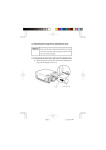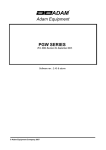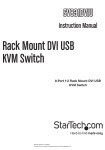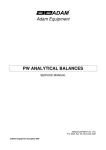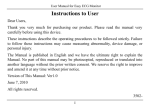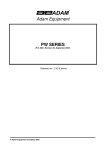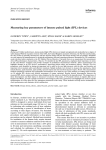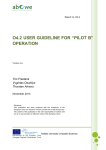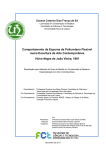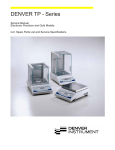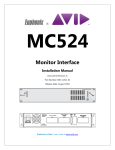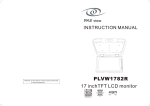Download Adam Equipment PGW PRECISION BALANCES
Transcript
Adam Equipment PGW PRECISION BALANCES SERVICE MANUAL ADAM EQUIPMENT CO. LTD. P.N. 8236, Rev. A7, April 2007 @Adam Equipment Company 2007 @Adam Equipment Company 2007 CONTENTS 1.0 INTRODUCTION ..........................................................................................................3 2.0 DESCRIPTION OF CONSTRUCTION..........................................................................4 2.1 PRINCIPLE OF OPERATION................................................................................4 2.2 MODEL DIFFERENCES .......................................................................................6 2.3 INTERNAL CALIBRATION BALANCES................................................................7 2.4 EQUIPMENT AND TOOLS REQUIRED................................................................8 3.0 COMMON FAULTS .....................................................................................................9 4.0 TROUBLE-SHOOTING GUIDES ...............................................................................10 5.0 FUNCTIONAL TESTS AND ADJUSTMENTS............................................................13 5.1 REPEATABILITY TESTING AT INTERNAL CALIBRATION MASS ....................13 5.2 REPEATABILITY TESTING AT FULL CAPACITY ..............................................14 5.3 ECCENTRIC LOADING TESTING ......................................................................15 5.4 LINEARITY TESTING .........................................................................................17 6.0 MECHANICAL REPAIRS ..........................................................................................19 7.0 DEALER PARAMETERS ..........................................................................................25 8.0 INTERNAL CALIBRATION MASS ADJUSTMENT....................................................28 9.0 CABLES AND CONNECTIONS ................................................................................30 10.0 BALANCE MENU DIAGRAMS..................................................................................31 11.0 BALANCE DIAGRAMS ............................................................................................34 11.1 EXPLODED VIEW...............................................................................................34 11.2 MAIN MECHANICS ASSEMBLY.........................................................................35 @Adam Equipment Company 2007 1 @Adam Equipment Company 2007 2 1.0 INTRODUCTION The PGW series of precision balances are very precise measuring devices used in the laboratory conditions. To achieve precise measurements you should make sure the balances are used in suitable environments and the conditions are as described in the Operators Manuals. There are no user serviceable parts in the balance. All service and internal calibrations should be done only by Service Personnel trained and approved by Adam Equipment. • • • • • • • • • • FEATURES: • Large easy to read LCD display with backlight • Standard applications include Weighing, Check weighing, Percentage Weighing, Parts Counting, Animal/ Dynamic Weighing, Net/Total and Density Determination • Internal Calibration using motorised internal calibration weight • External calibration models available • Bi-directional RS-232 interface • Can be configured to print a GLP Compliant report after each calibration to include the PGW series time, date, balance number and a verification of the calibration Automatic temperature compensation Display in 4 languages- English, French, German and Spanish 18 weighing units Capacity tracker Date and time Easy to use, sealed keypad Below balance weighing facility Password protection Security locking point Robust metal casing @Adam Equipment Company 2007 3 2.0 DESCRIPTION OF CONSTRUCTION 2.1 PRINCIPLE OF OPERATION The PGW balances use an electro-magnetic force restoration (or force motor) type mechanics that converts a force generated due to an unknown mass placed on the weighing pan into a voltage which can be measured by a high-precision voltmeter. The force restoration system uses a magnet section along with a coil to convert a current through the coil into a force. This force will balance the force caused due to the unknown mass on the balance pan. This is accomplished in a system using a method of applying the force from the unknown mass on one end of a beam and balancing it with the force generated due to the current in the coil on the opposite end. The balance position is detected by an optical detector connected to the beam. When the mass is placed on the balance pan, the beam will be moved out of its original null position. This movement is detected by the optical sensor. An amplifier connected to the sensor will change the current through the coil, to force the beam to go back to its null position. The amount of change in the current through the coil is proportional to the unknown mass on the pan. The current passes through a precision resistor, creating a voltage that is measured by the A/D converter. Mechanical parts surrounding the balance beam make the force generated due to the unknown mass go in a straight line through the balance beam, thus eliminating any differences, depending upon the location of the mass on the balance weighing pan. The electronics measure the voltage using precision amplifiers, A/D converter with high resolution and a microprocessor working with memory, displays and power supply. The microprocessor uses information from the A/D converter, a separate temperature sensor & A/D converter for measuring the magnet temperature and the internal program to determine the weight of the unknown mass and all other information to be displayed. The system uses special programs to correct any temperature variations in the mechanism. The balance is tested and calibrated at extreme temperatures and the details are stored in the memory. These details are used to compensate for temperature changes inside the balance due to self heating and ambient conditions. The internal calibration models include an internal calibration weight controlled by the microprocessor. This weight is not accessible by the user. Calibration can be performed when the temperature sensor detects a change in the pre-set temperature (or the pre-set time) either automatically or by manually entering in to the Calibration Menu. @Adam Equipment Company 2007 4 ELECTRONICS MODULES Within the balance there are electronic modules for: • Main PCB assembly including analogue circuit • Interface PCB assembly includes power supplies & RS-232 circuits • Display PCB • Calibration motor system (for internal calibration models) PRINCIPLES OF BALANCE MECHANISM: Details of the operation of the balance are found in the PGW User Manual. @Adam Equipment Company 2007 5 2.2 MODEL DIFFERENCES The PGW Series of balances have capacities that vary from 150g to 4500g. The basic electronics and software are identical, the only differences between the models are: • Value of current sense resistors are selected to optimise the voltage to the A/D converter. • The flexures- See Table 1 for details. • Pan support springs or leaf springs. • The external and internal calibration models- the internal calibration models are available with motorised internal calibration as series denoted with ‘i’. The same models are available with external calibration facility as series denoted with ‘e’. • All other changes are set by parameters stored in memory and set at the factory by the manufacturer and can not be modified outside the factory. TABLE 1: LIST OF FLEXURES Flexures (for 0.01g models) Flexures (for 0.001g models) Horizontal x 8 Puller x 1 Pivots x 2 NOTE: To order for spare flexures, refer to Table: 14 at the end of this manual. @Adam Equipment Company 2007 6 2.3 INTERNAL CALIBRATION BALANCES The mechanism for controlling the internal calibration mass consists of: -Internal calibration masses (1) -Retaining Plates (2) -Lever for mechanism (3) to move the masses -Electrical motor (4) with cam (5) operated from the microprocessor -Motor Bracket (6) -Position Sensor (7) -Weight hanger (8) -Plastic weight lifter (9) 2 7 1 6 9 4 8 5 3 1 2 Exploded view of Internal Calibration Mechanism for PGW with 0.001 readability NOTE: For PGW with 0.01 readability, components number 1 & 2 vary from the above, the rest of the components are same. Internal Calibration process can be started by user (using calibration menu and selecting the internal calibration option) or automatically when the time or temperature of the system changes by a pre-set value with respect to the time or temperature of last calibration. Automatic Calibration function can be disabled by the user in the calibration sub-menu. @Adam Equipment Company 2007 7 2.4 EQUIPMENT AND TOOLS REQUIRED The following tools and equipment may be helpful when working on the balance. GENERAL TOOLS AND EQUIPMENT Screwdriver Philips Screwdriver Medium Flat Allen Hex Keys3 mm 4 mm Needle Nose Pliers Soldering iron Precise square Slide calliper magnifier X10 Voltmeter Oscilloscope SPECIAL TOOLS AND EQUIPMENT Weighing mass OIML Class F1 Calibration and test masses should be used that will cover the weighing range of thee balance to be tested. The masses should be of high accuracy or the actual mass should be known if less accurate masses are used. A Constant Temperature Chamber or alternatively, a room capable of holding a steady temperature of ±1°C and a differential temperatures of minimum 10ºC and have a suitable table or platform for the balances to be stable for performing the temperature compensation. This is required if the memory is cleared, wrong temperature compensation values are used or if the magnet has been modified. Repair of flexures normally do not require temperature compensation. See Table 9 details. Suitable place for temperature tests @Adam Equipment Company 2007 8 3.0 COMMON FAULTS Faults associated with these balances leading to inaccurate weighing are generally of the following types. a. Calibration and Linearity faults b. Mechanical faults c. Electronics faults A general troubleshooting section follows in section 4.0. In order to know if a balance is working properly, it will be necessary to carry out some performance tests on the balance. See section 5.0 for the details. A brief description of the mechanical adjustments is covered in section 6.0. In most cases, the first thing to be considered as a part of trouble-shooting is the software parameters as this is the main method used to set calibration and linearity, set parameters, view temperatures sensor values and perform the most basic of calibration functions. See section 7.0 to enter the Dealer Parameter Settings. Faults associated with these balances leading to inaccurate weighing are generally of the following types. a. Calibration and Linearity faults (See section 5.0 & 7.0) b. Mechanical faults (See section 6.0) c. Electronics faults (See the note below) NOTE: The Electronics modules within the balance are not serviceable. In case of any electronics component failure, contact your supplier. @Adam Equipment Company 2007 9 4.0 TROUBLE-SHOOTING GUIDES Service of a balance will generally be necessary when the balance does not perform as expected. The balances are not user-serviceable. Problems usually fall into one of the following categories: User Problems: The user is asking the balance for something it cannot do or is confused by the modes and functions of a balance. It is also possible the user has set a parameter that has affected the balance operation. Resetting the parameter to a normal value will restore operation. Mechanical Problems The balances consist of complicated and fragile mechanical devices. They can be damaged by placing a weight on it which is too high for the balance or by dropping the balance or occasionally shipping it without taking care. The most fragile parts are the flexures. Dust, dirt, spills and other foreign objects in the balance can also cause problems. Electronic Problems: These are the rarest of the problems affecting balances. If an electronic problem is suspected make sure the mechanical problems that can cause similar symptoms have been eliminated before attempting electronic repairs. With the exception of cables most electronic repairs are solved by PCB replacement. The Electronics modules within the balance are not serviceable. In case of any electronics component failure, contact your supplier. The following table provides a guideline on the common problems. Note that many problems may have multiple solutions and there may be problems found that are not listed in the table. For more Information, contact your supplier. TABLE 2: TROUBLE-SHOOTING BALANCE DOES NOT FUNCTION Problems Possible causes Suggestions The balance is dead when power is applied Power supply failure Check adapter is working Cable / Connector failure Check adapter is correct for the balance Normal adapter is 15VDC, 800mA. *Power supply circuit board failure *Short circuit on any circuit board The display does not turn on but the calibration motor moves when power is applied Power is getting to balance, display is not working @Adam Equipment Company 2007 10 *Display cables may be faulty *Display module failure The display stays on the initial test screen when power is applied. Calibration weight motor is on. Unstable balance Balance not working correct Power supply *Check if balance is stable by using service menu and view A/D values Put draught shield over pan Check power supplies BALANCE WORKS BUT IS NOT STABLE Balance is unstable by a few divisions Noise or vibration from environment Friction in mechanics Check the balance is positioned correctly to avoid vibration, wind or air movement, it is on a solid table, It is not near sources of heat or cool air, Check balance with weights if problem occurs when sample is used. Static electricity on the samples can cause drifting and instability. Check the area around the weighing pan for hair, dust, obstructions under the pan, *A complete inspection of the mechanics to look for sources of friction may be needed. Balance is very unstable and does not weigh correctly Mechanical problems Balance programming Check whether the temperature is changing or there is a draught. *A complete inspection of the mechanics to look for sources of friction. *Verify the A/D is also unstable. If the A/D is OK then suspect the programming of the balance. Reset parameters, check temperature compensation, and redo the calibration. Electronic problems Some electronic problems can also cause this. But all mechanical problems must be resolved first. BALANCE IS NOT ACCURATE You must have accurate and trusted weights to test a balance. If you suspect that the balance is not accurate then you must know your weights are accurate. A balance calibrated using a bag of flour is not accurate even if it works OK otherwise. Balance is not accurate Repeatability Verify the balance shows the same value when the same mass is placed on the centre of the pan for a few tests. Eccentric loading Verify the balance shows the same reading (within a tolerance depending upon the model) when a mass is placed at positions around the pan. Linearity Poor Repeatability Verify the balance is acceptable throughout the weighing range. The balance must give acceptable readings from low weights up to the capacity. Usually a mechanical problem. Inspect the area around the pan for hair, dust or other obstructions, *Inspection of the mechanics may be @Adam Equipment Company 2007 11 needed for any possible problems. Poor Eccentric loading A mechanical problem Inspect the area around the pan for hair, dust or other obstructions, *Inspection of the mechanics may be needed for any possible problems. *Readjusting of the Eccentric loading is recommended. Poor Linearity Usually a mechanical problem Re-check repeatability *Inspection of the flexures for damage or loose hardware may be required *Use the Linearity Function in the service menu to reset linearity Electronic Problems *A problem in the analogue circuit board or power supplies can cause poor linearity. Make sure all mechanical problems have been eliminated first OTHER PROBLEMS Cannot calibrate Zero shifted more than allowed *Check all flexures for damage *Reset factory calibration *Verify linearity and repeatability Calibration timeout *The balance may be unstable. Verify stability as above. Try using a more aggressive filter Calibration weight motor does not stop *Check the cables to the motor, try plugging the balance into the power again *Look for friction in the calibration weight movement *Check the opto-coupler that controls the motor position. RS-232 not working Doesn’t print Check parameters match the device connected Verify cable is correct *RS-232 circuits damaged Display dark, keys beep Display contrast poor *Check the cables to the display Cable damaged *Replace display-it may be damaged LCDs on the display are faulty or damaged *To be carried out by authorised technicians only. 5.0 @Adam Equipment Company 2007 12 FUNCTIONAL TESTS AND ADJUSTMENTS In order to know if a balance is working properly, it will be necessary to carry out the following tests on the balance. These tests should be performed initially, when it is not clear whether there is any problem with the balance. These tests should also be performed anytime a balance has been serviced or any changes are made. Before performing the tests the balance should be allowed to warm-up in a stable environment for a minimum of 4 hours. During this time the following should be checked: • Install the pan supports, the pan and the breeze-shield, if applicable and make sure they do not interfere with correct weighing. • Level the balance. • Verify all the keys work properly and the functions set are suitable for the balance to be tested. For example, set to grams weighing, all digits operating normally, the filters set to a normal setting, etc. • Verify the RS-232 is operating correctly using a communications program. • Verify the display is correct, the minus sign is shown, decimal points are in the correct position, the weighing unit is correct and the stability symbol is correct. • Verify the calibration is functioning correctly. For better accuracy, we suggest to use only the Class F1 weights during the linearity adjustment. The maximum permissible errors of F1 weights are given in the Table below. TABLE 3: OIML R-111 TEST WEIGHT TOLERANCES 5.1 Value of Class F1 weights Maximum Permissible Error Value of Class F1 weights Maximum Permissible Error 5000 g 2000 g 1000 g 500 g 200 g ± 0.025 g ± 0.010 g ± 0.005 g ± 0.0025 g ± 0.0010 g 100 g 50 g 20g 10g ± 0.0005 g ± 0.0003 g ± 0.25 mg ± 0.020 mg REPEATABILITY TESTING AT INTERNAL CALIBRATION MASS Repeatability is checked at the approximate value of the internal calibration mass. • • • • • Perform automatic calibration. Place the right weighing mass on the pan as shown in the table below. Repeat this procedure 5 times. Compare the reading results with the actual mass. Compare results, the readings with the mass on the pan should agree within the acceptable error as shown. @Adam Equipment Company 2007 13 TABLE 4: REPEATABILITY ERRORS AT INT. CAL. MASS 5.2 Balance model PGW 153 PGW 253 PGW 453 Mass 100g 240g 240g Acceptable error ± 0,002 g PGW 753 520g ± 0,002 g PGW 1502 1400g ± 0,02 g PGW 2502 1400g ± 0,02 g PGW 3502 1400g ± 0,02 g PGW 4502 1400g ± 0,02 g ± 0,002 g ± 0,002 g REPEATABILITY TESTING AT FULL CAPACITY • • • • • Place the mass on the pan as shown in the table below. After stabilization record the reading. Take off the mass and after stabilization record the reading with no mass on the pan. Repeat 5 times. Compare results, the readings with the mass on the pan should agree within the acceptable error as shown. TABLE 5: REPEATABILITY ERRORS AT FULL CAPACITY Balance model PGW 153 PGW 253 PGW 453 Mass 150g 250g 450g Acceptable error (S.D.) ± 0,002 g PGW 753 750g ± 0,002 g PGW 1502 1500g ± 0,02 g PGW 2502 2500g ± 0,02 g PGW 3502 3500g ± 0,02 g PGW 4502 4500g ± 0,02 g ± 0,002 g ± 0,002 g REPEATABILITY ADJUSTMENT: If the errors are still not acceptable, refer to section 7.0 for adjustment. @Adam Equipment Company 2007 14 5.3 ECCENTRIC LOADING TESTING • • • • • • Check the balance readings in the positions marked. Place the mass shown in the table below at the center of the pan. After stabilization, record the value. Move the mass to the next point, half way between the center and the edge of the pan. Record the results for each point. The readings on the edges should match with the reading at the center point within the tolerances shown. TABLE 6: ECCENTRIC LOADING ERRORS Balance model PGW 153 PGW 253 PGW 453 Mass 50g 100g 200g Acceptable error ± 0,002 g ± 0,002 g ± 0,002 g PGW 753 400g ± 0,002 g PGW 1502 500g ± 0,02 g PGW 2502 1000g ± 0,02 g PGW 3502 1000g ± 0,02 g PGW 4502 1000g ± 0,02 g If the differences in the weighing values at the 5 locations are bigger than ±5 divisions, you need to adjust the balance for Eccentric loading. ECCENTRIC LOADING ADJUSTMENT: These adjustments will result in moving the mounting points for the flexures so that the mechanical assembly is set right to produce the same weighing results regardless of the position of the mass on the weighing platform. The adjustment is done using the hex head bolts on the mechanics: The amount of adjustment and the direction by which the screws are turned will depend on the amount of error observed as the mass is moved around the platform. @Adam Equipment Company 2007 15 Hexagonal Screws • • • • • • • • Place the balance on a suitable and stable surface. Take off the cover of the balance. Do not unplug the display cable. Mount the pan on the pan supports. Locate the hexagonal screws to adjust the eccentric loading. Always adjust for the largest differences first, i.e., either the difference in value when the mass is placed at back to front or that of side to sidewhichever difference is the largest should be adjusted first. Re-check the readings after each adjustment. For small corrections the bolts will be turned by very small angles. The value of the mass used for adjustment should be of 1/3 to ½ of the balance capacity. When placing the mass on the pan, locate it at ½ the distance from the centre to the edge. Refer to the following instructions for detailsA. When the difference is greater in case of back to front of the pan than that of side to side, do the front to back adjustment first - @Adam Equipment Company 2007 16 If the reading is more at the front, turn both the screws clockwise by the same angle. If the reading is more at the back, turn both the screws anti-clockwise by the same angle. B. When the difference is greater in case of the mass placed from side to side than that of the mass placed from back to front, do the side to side adjustment first - If the reading is more at the right side of the pan, turn the left screw anticlockwise and the right screw clockwise by the same angle. If the reading is more on the left side of the pan, turn the left screw clock-wise and the right screw anti-clockwise by the same angle. After setting the adjustment, you should place the balance to one side for some time and weigh on it occasionally. This helps to reduce the internal tensions. Re-test again and continue adjusting, if necessary. 5.4 LINEARITY TESTING • Place the weights on the balance covering the balance range- from min to max, as suggested in the table below. • Check deviations of the displayed values from the actual values on the weights on pan. • If necessary re-calibrate. Ensure the environment is stable, the warm up time is as specified and only the Class F1 weights are used during calibration. • Check accuracy of linearity. If the values are still not acceptable, contact your supplier. @Adam Equipment Company 2007 17 Examples of the weights that can be used for testing are given in the following table: TABLE 7: SUGGESTED MASS FOR THE LINEARITY TESTING PGW 153 10g 20g 30g PGW 253 20g 50g PGW 453 50g PGW 753 40g 50g 60g 80g 100g 120g 150g 80g 1000g 120g 150g 180g 200g 220g 250g 100g 120g 150g 200g 250g 300g 350g 400g 450g 100g 200g 250g 300g 400g 450g 500g 600g 700g 750g PGW 1502 100g 200g 300g 400g 500g 600g 800g 1000g 1200g 1500g PGW 2502 500g 600g 800g 1000g 1200g 1500g 1700g 2000g 2200g 2500g PGW 3502 500g 600g 800g 1000g 1200g 1500g 2000g 2500g 3000g 3500g PGW 4502 500g 1000g 1200g 1500g 2000g 2500g 3000g 3500g 4000g 4500g It is necessary to know the values of the masses used to an accuracy that is better than the balance weighing results. NOTE: The accumulation of errors when using multiple masses can contribute to a larger apparent error. Refer to Table 3. If you are using 200g & 50g masses to make 250g, there may be an accumulated error of (0.0010g + 0.0003g) 0.0013g. The error at each value is determined by computing: Error = Displayed mass – actual mass TABLE 8: LINEARITY ERRORS Balance model PGW 453 Acceptable error ±0.003g ±0.003g ±0.003g PGW 753 ±0.003g PGW 1502 ±0.03g PGW 2502 ±0.03g PGW 3502 ±0.03g PGW 4502 ±0.03g PGW 153 PGW 253 LINEARITY ADJUSTMENT: If the values are still not acceptable, refer to section 7.0 for Linearity adjustment. @Adam Equipment Company 2007 18 6.0 MECHANICAL REPAIRS The mechanical repairs which are normally required will be: -Replace broken or damaged flexures -Cleaning or replacing of magnet and drive coil Each of these is explained in the following section. The part numbers for ordering the components needed during the repair are listed in the Annexure at the end (see Table 13). Step 1: To open the PGW Balance, first remove the two screws on the rear panel using the 2.5mm Allen Hex Keys. Rear Screw 1 Rear Screw 2 Step 2: Remove the stainless steel pan and the 4 rubber pan supports. Stainless Steel pan Rubber pan support Step 3: Hold the balance up side down and remove the 2 front screws using the 3mm Allen Hex Keys. 2 bottom screws Step 4: Next you will need to remove the top saddle by removing the two screws using the 3mm Allen Hex Keys. Remove the pan support spacers. 3 mm Allen Hex Keys Top saddle @Adam Equipment Company 2007 19 At this stage the balance is ready to be opened as shown in the next step. Step 5: Press the spirit level lug downwards with one hand and lift the top case with the other hand. Spirit Level Lug Display Cable Step 6: To detach the top case, remove the Display Cable and the Keypad Cable from the main PCB. Keypad Cable Step 7: To detach the top pan support bracket from the Mechanics, use the 3mm Allen Hex Keys to remove the 2 screws Top pan support bracket Flexures Magnet cover Mechanics @Adam Equipment Company 2007 20 You can view the Mechanics with the top horizontal flexures and the magnet with cover. Step 8: If you need to clean the Drive Coil and the magnet, remove the 2 screws attached to the magnet cover using the 4mm Allen Hex Keys. Magnet Cover Square Tool Step 9: It is suggested to add the Square Tool at this stage to protect the flexures from getting damaged during any repair work. Step 10: Unsolder the Drive Coil Wires. Note the position of the coil drive wires on the board to remove the mechanics from the case. If not reconnected correctly, the balance will not work. Step 11: Next you will need to remove the bottom case. Turn the balance up side down and remove the 3 screws using the 3mm Allen Hex Keys. @Adam Equipment Company 2007 21 Step 12: Lift the case carefully leaving the mechanics on the work surface. Step 13: If you need to change any of the flexures hold the assembly firmly as shown. Remove the damaged flexure by using the 3 mm Allen Hex Keys and fix the new one. Fix the assembly back into the base when complete. If you need to replace any flexure, the following guidelines may help. • Replace only with the correct flexure procured from Adam Equipment. See table 1 for details • If possible only replace one flexure at a time. • Keep all flexures aligned vertically, horizontally and from front to back. • The active area of a flexure must align with the active area of all other flexures in the same axis. • Do not over-tighten the flexure screws. Residual stress is often a cause of drift with temperature or unstable readings. When tightening the screws work slowly from one screw to the others to tighten all screws a little at a time. • Do not allow the flexures to twist when tightening the screws. • Be certain you are using the correct flexures for the balance. Many flexures look very similar but have different applications. The major difference between similar flexures is the thickness of the active area. • Be very careful not to bend flexures during installation. Remember flexures are designed to be very weak in the direction they bend. They are not strong enough to support a large weight in the bending direction. @Adam Equipment Company 2007 22 Power Board Step 14: To have the access to the Puller and vertical flexures, the Power Board and the back panel needs to be removed. Remove board by using 3mm Allen Hex Key as shown here. Step 15: Next pull out the back panel holding with both the hands. Back Panel Vertical Flexure Step 16: The Puller Flexure can then be accessed for repair as shown here. Use the 3mm Allen Hex Key Puller Flexure Step 17: After all repair work is done, follow the steps backwards to reassemble the balance. Remove the cap covering the weigh below hook by lifting it from the base. Step 18: While fixing back the bottom case, use the weigh below as a reference for correct alignment. @Adam Equipment Company 2007 23 Step 19: Ensure the weigh below is in the exact centre of the hole provided for installing the hook. Step 20: After the repair it is suggested that the balance is Temperature-calibrated using a Constant Temperature Chamber or in a suitable room, particularly for few cases as described in Table 9. PGW Inside a Constant Temperature Chamber TABLE 9: GUIDELINE FOR TEMPERATURE COMPENSATION REPAIR UNDERTAKEN Calibration Performed Linearity adjusted Eccentric Loading adjusted Flexures repaired or replaced Magnet and/or drive coil cleaned Magnet and/or drive coil replaced Temperature sensor replaced Data erased or amended PCBs replaced @Adam Equipment Company 2007 REMARKS ON TEMP. COMPENSATION Not required Not required Not required Normally not required Not required Must be done Must be done Must be done Must be done 24 7.0 DEALER PARAMETERS The parameters available to the users are described in the User Manual in details. This section describes the parameters available to the dealers for setting up the balance. Access to these parameters is controlled by password. • From the supervisor menu, select the PASSCODES option. • From the PASSCODES menu, select the OPERATOR option. • Enter the dealer passcode, which is 41218 (DLR as D=4th L=12th R=18th letter of the alphabet). Press [Setup/Enter]. • Press the [Mode] key three times, or press the [Esc] key to return to weighing and then the [Setup/Enter] key to return to the outer level menu, which now displays “SUPERVISOR”. • From this menu select the DEALER option. Available options on the dealer menu are: 1. ADC COUNTS The balance displays the averaged, temperature compensated and linearity corrected weight ADC counts in the small digits and the spread of the last 50 readings in the large digits. • Pressing the [Unit] key switches the display between the weight and temperature ADC counts. • Temperature counts display is indicated by a ‘T’ symbol and shows the individual temperature ADC counts in the small digits and the average of the last 10 readings in the large digits. • Pressing the [Setup/Enter] or [Mode] key escapes to the next item on the dealer menu. • Pressing the [Esc] key returns to weighing. TABLE 10: WEIGHT ADC Zero Setting Maximum Linearity Load (See Table 8) ADC Range > 500,000 < 16,000,000 0.5 to 1.5 million 14 -16 million @Adam Equipment Company 2007 25 TABLE 11: MAXIMUM LINEARITY LOAD BALANCE MODEL MAXIMUM LINEARITY LOAD PGW 153 PGW 253 PGW 453 PGW 753 PGW 1502 PGW 2502 PGW 3502 PGW 4502 160g 260g 475g 800g 1600g 2600g 3750g 4750g 2. DATA COMMS • Displays “ACTIVE” when selected. • Pressing the [Print] key sends the stored configuration data as a formatted table with address headers to the RS-232 port at 9600 baud, 8 bits, no parity, irrespective of the settings chosen in serial setup on the supervisor menu. • Pressing the [Setup/Enter] or [Mode] key escapes to the next item on the dealer menu. • Pressing the [Esc] key returns to weighing. 3. CALIBRATE This menu offers two options: A. TEMP CAL • Select the LOW or HIGH temperature calibration point. • Enter the balance temperature (10 to 40 deg C). • If the low temperature calibration point is selected, the entered temperature must be at least 10 degrees below the one stored for the high temperature calibration point, otherwise the display will show “ERROR HI”. • If the high temperature calibration point is selected, the entered temperature must be at least 10 degrees above the one stored for the low temperature calibration point, otherwise the display will show “ERROR LO”. • If the entered temperature is within range, the display will show the message “LOAD 0”. @Adam Equipment Company 2007 26 • Ensure that the weight pan is clear, then press [Setup/Enter]. • After measuring the no-load weight, the display will prompt to load the external calibration mass. Load the required mass and press [Setup/Enter]. • If temperature calibration at the other temperature has already been performed successfully, after measuring the weight of the calibration mass the instrument will display the current temperature correction in parts per million per degree Celsius as “PPM CORR xxx” until any key is pressed to return to the TEMP CAL menu option. If temperature calibration at the other temperature has not been performed, the instrument will return immediately to the TEMP CAL menu option. • Pressing the [Mode] key at any time escapes back to the TEMP CAL menu option. • Pressing the [Esc] key at any time returns to weighing. • If any measurement errors are encountered, an appropriate error message will flash on the display until any key is pressed, when the instrument will return to the TEMP CAL menu option. • If any errors are encountered or the [Mode] or [Esc] keys are pressed during temperature calibration, the procedure will be aborted with no new data stored, and any previous temperature correction data will be retained. B. LINEAR CAL • Display will ask to load the required weights in turn. Place the weights onto the weighing pan in turn and press the [Setup/Enter] key. Please note that the weights are not selectable • Pressing the [Mode] key at any time escapes back to the LINEAR CAL menu option. • Pressing the [Esc] key at any time returns to weighing. • If any measurement errors are encountered, an appropriate error message will flash on the display until any key is pressed, when the instrument will return to the LINEAR CAL menu option. • If any error is encountered or the [Mode] or [Esc] keys are pressed during linearity calibration, the procedure will be aborted with no new data stored and any previous linearity calibration data will be retained. @Adam Equipment Company 2007 27 TABLE 12: MASSES NEEDED FOR LINEARITY CALIBRATION BALANCE MODEL PGW 153 PGW 253 PGW 453 PGW 753 PGW 1502 PGW 2502 PGW 3502 PGW 4502 8.0 MASSES FOR LINEARITY CALIBRATION 10g, 20g, 30g, …….….up to 160g 20g, 40g, 60g,………...up to 270g 25g, 50g, 75g,………...up to 475g 50g, 100g, 150g, ….….up to 900g 100g, 200g, 300g, .….up to 1600g 200g, 400g, 600g…....up to 2700g 250g, 500g, 750g,.…..up to 3750g 250g, 500g, 750g…....up to 4750g INTERNAL CALIBRATION MASS ADJUSTMENT TABLE 13: LIST OF INTERNAL CALIBRATION WEIGHTS PGW 153i PGW 253i PGW 453i Internal Calibration mass (approx.) 100g 240g 240g PGW 753i 520g PGW 1502i 1400g PGW 2502i 1400g PGW 3502i 1400g PGW 4502i 1400g Balance model NOTE: The value of the internal mass is not an exact number, such as 100g. It must be set by comparing with an external mass. The exact value can be set using the Supervisor Parameter section as described in the User Manual (section 13.5), provided this feature is enabled at the factory. PROCEDURE • Make sure the balance is level and has been ON for 4 hours or more at a stable temperature. • Calibrate the balance twice. This helps to reduce any stresses in the mechanics. • To verify the accuracy of this internal calibration, place an external mass approximately equal to the same internal calibration mass. Record the result. @Adam Equipment Company 2007 28 • Enter the Internal Calibration section using the Supervisor passcode as per the following procedure- • Pressing the [Setup/Enter] key while in normal weighing gives access to the Supervisor Menus. • When [Setup/Enter] is pressed and passcodes are not enabled the display will show the Supervisor menus. If passcodes are enabled, the balance will ask for it by displaying “PASSCODE 0” • If a wrong code is entered an “ERROR CODE” message will flash and the balance will return to weighing mode • If the passcode has been enabled and entered, the balance will allow the user to access the Supervisor’s menus by which the user can enable/disable weighing units or modes, set balance parameters for the conditions, set time and date, set parameters for the RS-232 interface, calibration parameters and security parameters • The display will show the first menu “UNITS”. The [Up] and [Down] keys will cycle through the main menus, pressing the [Setup/Enter] key will enter the menu and sub-menu or options can be set. Press [Mode] to come out of a sub-menu or [Esc] to return to normal weighing • Press [Enter] when “CAL SETUP” is displayed to select the calibration parameters • The options for each parameter can be scrolled through by using the [Up] or [Down] key • When “INT CAL” is displayed select “YES” by pressing the [Enter] key. . The value of the internal mass set in the factory will be displayed • A new internal value can then be reset to make the external mass value display correctly. If the reading for the external mass is greater than the actual value of the mass then reduce the internal mass value by the difference. Enter this reduced value when prompted by the display For example, if the internal mass previously set is 520.054g and the display reads 500.050g when using an external mass of 500g, then reduce the internal mass value by 0.050g. Enter the new revised value of 520.004 (in place of 520.054g) when prompted. The adjustment can be done for up to ±100mg. • Repeat the calibration and check the value of the external mass again • Repeat this procedure until the value displayed is correct for the mass used • Press [Esc] to return to normal weighing @Adam Equipment Company 2007 29 9.0 CABLES AND CONNECTIONS @Adam Equipment Company 2007 30 10.0 BALANCE MENU DIAGRAMS @Adam Equipment Company 2007 31 @Adam Equipment Company 2007 32 @Adam Equipment Company 2007 33 11.0 BALANCE DIAGRAMS 11.1 EXPLODED VIEW Stainless Steel pan Pan Support Assembly Pan Support Spacers x 4 Power Supply PCB Mechanics Main PCB Magnet Assembly Balance Casing Foot @Adam Equipment Company 2007 34 11.2 MAIN MECHANICS ASSEMBLY Magnet Cover Upper Horizontal Beam Main Chasis Optical switch Off-Centre Loading Assembly Coil Beam Assembly Magnet Assembly Pivot Puller Lower Horizontal Beam Horizontal Flexure @Adam Equipment Company 2007 35 ANNEXURE TABLE 14: PGW SELECTED PART NUMBERS COMPONENT Main PCB Filter PCB Display PCB Power PCB (includes RS-232) Flexures for PGW 153, 253, 453 & 753 Horizontal x 8 Puller x 1 Pivots x 2 Flexures for PGW 1502, 2502, 3502 & 4502 Horizontal x 8 Puller x 1 Pivots x 2 Feet Keypad Stainless Steel Pan, 192 x 192mm Stainless Steel Pan, 140 x 140mm Pan Support Bracket (for PGW 153, 253, 453 & 753) Pan Support Bracket (for PGW 1502, 2502, 3502 & 4502) Rubber Pan Support (set of 4) Anti-static Springs Circlip (circular clip to retain the pan support in place) Power Supply Adapter Square Glass Breeze Shield Internal Calibration Motor Internal Calibration Cam Return Spring Optical Position Sensor (complete assembly) Power Cable Display Cable Internal Cal Motor and Opto Cable Temperature Sensor Cable PART NUMBER 7067 8087 6095 7068 8665 8663 8664 8666 8665 8663 7064 7073 7074 7075 7052 7045 7047 7512 7242 7326 7449 7091 7094 7180 7033 7228 7234 7237 7191 NOTE: Refer to the drawings for the item number corresponding to this list. If spare parts are required identify the model number and serial number of the balance. Contact your supplier for further details on price and availability of all spare parts. The circuit boards do not have user serviceable parts. @Adam Equipment Company 2007 36 Manufacturer’s Declaration of Conformity This product has been manufactured in accordance with the harmonised European standards, following the provisions of the below stated directives: Electro Magnetic Compatibility Directive 89/336/EEC Low Voltage Directive 73/23/EEC Adam Equipment Co. Ltd. Bond Avenue, Denbigh East Milton Keynes, MK1 1SW United Kingdom FCC COMPLIANCE This equipment has been tested and found to comply with the limits for a Class A digital device, pursuant to Part 15 of the FCC Rules. These limits are designed to provide reasonable protection against harmful interference when the equipment is operated in a commercial environment. The equipment generates, uses, and can radiate radio frequency energy and, if not installed and used in accordance with the instruction manual, may cause harmful interference to radio communications. Operation of this equipment in a residential area is likely to cause harmful interference in which case the user will be required to correct the interference at his own expense. Shielded interconnect cables must be employed with this equipment to insure compliance with the pertinent RF emission limits governing this device. Changes or modifications not expressly approved by Adam Equipment could void the user's authority to operate the equipment. WEEE COMPLIANCE Any Electrical or Electronic Equipment (EEE) component or assembly of parts intended to be incorporated into EEE devices as defined by European Directive 2002/95/EEC must be recycled or disposed using techniques that do not introduce hazardous substances harmful to our health or the environment as listed in Directive 2002/95/EC or amending legislation. Battery disposal in Landfill Sites is more regulated since July 2002 by regulation 9 of the Landfill (England and Wales) Regulations 2002 and Hazardous Waste Regulations 2005. Battery recycling has become topical and the Waste Electrical and Electronic Equipment (WEEE) Regulations are set to impose targets for recycling. @Adam Equipment Company 2007 37 ADAM EQUIPMENT is an ISO 9001:2000 certified global organisation with more than 30 years experience in the production and sale of electronic weighing equipment. Products are sold through a world wide distributor network supported from our company locations in the UK, USA, SOUTH AFRICA and AUSTRALIA. ADAM’s products are predominantly designed for the Laboratory, Educational, Medical and Industrial Segments. The product range is as follows: -Analytical and Precision Laboratory Balances -Counting Scales for Industrial and Warehouse applications -Digital Weighing/Check-weighing Scales -High performance Platform Scales with extensive software features including parts counting, percent weighing etc. -Crane scales for heavy-duty industrial weighing -Digital Electronic Scales for Medical use -Retail Scales for Price computing Adam Equipment Co. Ltd. Bond Avenue Milton Keynes MK1 1SW UK Adam Equipment Inc. 26, Commerce Drive Danbury, CT 06810 USA Adam Equipment S.A. (Pty) Ltd. 7 Megawatt Road, Spartan EXT 22, Kempton Park, Johannesburg Republic of South Africa Adam Equipment (S.E. ASIA) Pty Ltd. 2/71 Tacoma Circuit Canning Vale, Perth Western Australia Tel:+44 (0)1908 274545 Fax: +44 (0)1908 641339 Tel: +1 203 790 4774 Fax: +1 203 792 3406 Tel: +27 (0)11 974 9745 Fax: +27 (0)11 392 2587 Tel: +61 (0) 8 6461 6236 Fax: +61 (0) 8 9456 4462 E-mail: [email protected] E-mail: [email protected] E-mail: [email protected] E-mail: [email protected] © Copyright by Adam Equipment Co. Ltd. All rights reserved. No part of this publication may be reprinted or translated in any form or by any means without the prior permission of Adam Equipment. Adam Equipment reserves the right to make changes to the technology, features, specifications and design of the equipment without notice. All information contained within this publication is to the best of our knowledge timely, complete and accurate when issued. However, we are not responsible for misinterpretations which may result from the reading of this material. The latest version of this publication can be found on our Website. Visit us at www.adamequipment.com @Adam Equipment Company 2007 38








































